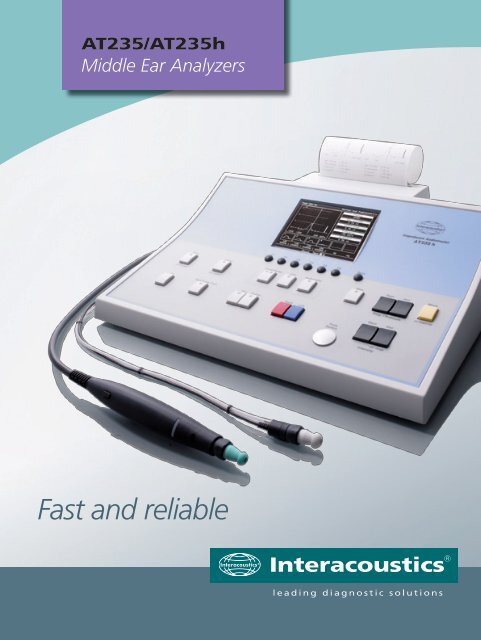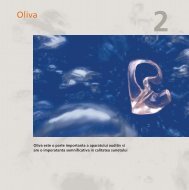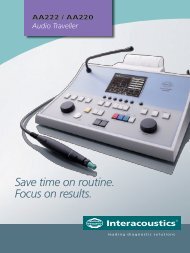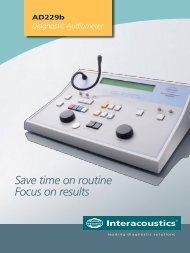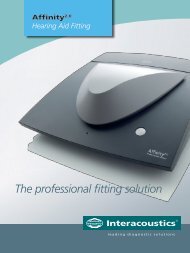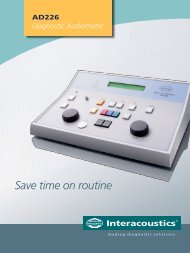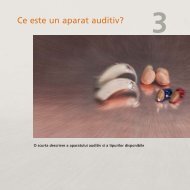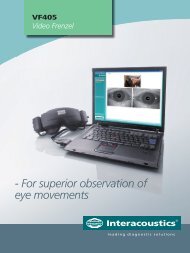AT235 and AT235h Leaflet.pdf - Sonorom
AT235 and AT235h Leaflet.pdf - Sonorom
AT235 and AT235h Leaflet.pdf - Sonorom
Create successful ePaper yourself
Turn your PDF publications into a flip-book with our unique Google optimized e-Paper software.
<strong>AT235</strong>/<strong>AT235</strong>h<br />
Middle Ear Analyzers<br />
Fast <strong>and</strong> reliable<br />
Interacoustics ®<br />
®<br />
leading diagnostic solutions
<strong>AT235</strong>/<strong>AT235</strong>h<br />
Middle Ear Analyzers<br />
Automated Eustrachian Tube<br />
Function test is available<br />
Tympanogram <strong>and</strong> reflex test<br />
results displayed simultaneously<br />
A group of increasing stimuli for<br />
reflex testing, clear displays reflex<br />
growth with inscreasing intensity<br />
High frequency screening<br />
tympanometry records the IYI<br />
tympanogram<br />
Fast <strong>and</strong> reliable<br />
The <strong>AT235</strong> is an automatic middle ear analyzer<br />
ideal for diagnostic <strong>and</strong> screening evaluations.<br />
The primary design of the <strong>AT235</strong> emphasizes ease<br />
of use without compromising testing flexibility.<br />
Test batteries of the <strong>AT235</strong> include st<strong>and</strong>ard tympanometry,<br />
ispsilateral <strong>and</strong> contralateral acoustic<br />
reflex <strong>and</strong> reflex decay, Eustachian tube function<br />
test <strong>and</strong> air conduction audiometry.<br />
Automated tympanometry may be combined<br />
with 2 programmable reflex test batteries. Further<br />
manual reflex testing is available for more tests or<br />
to confirm/modify automated reflex results. The<br />
<strong>AT235</strong> allows 78 reflex tests per ear to be stored<br />
<strong>and</strong> printed. These capabilities provide the necessary<br />
tests for the majority of any clinic’s needs.<br />
The addition of high frequency probe tones to<br />
optimize tympanometry testing of infants is available<br />
with the <strong>AT235</strong>h model.<br />
Normal tympanometry<br />
Interacoustics utilize two beneficial techniques to<br />
acquire tympanograms. The first is an ‘endless airflow’<br />
technique which improves the instrument’s<br />
ability to obtain a tympanogram on difficult to<br />
test patients or when a slight leak is present. This<br />
prevents the system from continually resetting to<br />
continue the test. The second feature is an intelligently<br />
controlled pump system with an adaptive<br />
speed control. This feature combines a very fast<br />
test speed with high resolution of the tympanogram<br />
peak which might otherwise be obtained<br />
only with a slower pump speed.<br />
<strong>AT235</strong>h - High frequency <strong>and</strong> manual<br />
tympanometry<br />
The <strong>AT235</strong>h provides additional high-frequency<br />
probe tones for Y-component testing in addition<br />
to the traditional 226Hz tone. With the push of<br />
a single button, the <strong>AT235</strong>h will switch to a 678,<br />
800 or 1000 Hz probe tone. A tympanogram that<br />
is recorded using a high frequency probe tone<br />
(e.g. 1000 Hz) is considered more suitable for<br />
screening neonates.<br />
In addition to automatic mode, the pump action<br />
on the <strong>AT235</strong>h can be controlled manually. In this<br />
mode, pressure increase/decrease is controlled by<br />
keys on the front panel. Pressure speed can be<br />
toggled between three speeds.<br />
User definable reflex test<br />
Two user programmable acoustic reflex sequences<br />
are available allowing the user to define a simple<br />
screening procedure for test A <strong>and</strong> a more indepth<br />
evaluation as test B. These protocols may<br />
be programmed <strong>and</strong>/or selected by the push<br />
of a button. The parameters for test A <strong>and</strong> B<br />
come with a factory default setting but are easily<br />
changed to better suit alternative clinical test<br />
routines. The protocols allow intensity presentations<br />
at fixed levels, in auto threshold mode or a<br />
defined sequence to display reflex growth. The<br />
<strong>AT235</strong> <strong>and</strong> <strong>AT235</strong>h allow mixing of ipsi <strong>and</strong> contra<br />
reflexes in the protocol as well as a variety of<br />
stimuli such as pure tones or noise b<strong>and</strong>s. There<br />
are few limitations on storing <strong>and</strong> printing as 78<br />
reflexes may be recorded per ear. All reflex testing<br />
may be done manually in addition to the automated<br />
routines.<br />
Decay – Contra <strong>and</strong> Ipsi<br />
Acoustic reflex decay testing is available with<br />
ipsilateral as well as with contralateral stimulation.<br />
The <strong>AT235</strong> comes with a st<strong>and</strong>ard single TDH39<br />
<strong>and</strong> a button insert receiver (CIR22) for stimulating<br />
the contralateral ear is available as an option.<br />
Eustachian tube function<br />
The <strong>AT235</strong> performs a single Eustachian Tube<br />
Function test suitable for use when the eardrum<br />
is intact. Instructions on the display guide the<br />
test. Three tympanograms are produced from<br />
which the condition of the Eustachian tube can<br />
be inferred.<br />
The <strong>AT235</strong>h has a further ETF test suitable for<br />
when the eardrum is perforated.
A moving train may help to keep<br />
children quiet during testing.<br />
Visual child distraction<br />
The <strong>AT235</strong> has a selection for a moving “choo<br />
choo train” on the screen to help keep the child<br />
distracted while running tympanometry tests.<br />
Probe Systems<br />
The <strong>AT235</strong> is supplied with a combi probe system<br />
that is easily interchanged for screening <strong>and</strong> clinical<br />
testing purposes. The screening probe tip is<br />
ideal for quick tymps <strong>and</strong> a screening reflex, while<br />
the diagnostic probe provides more stability for<br />
more lengthy exams that include tymps, reflexes,<br />
reflex decay <strong>and</strong> ETF. The probe has a button for<br />
changing ears remotely from the <strong>AT235</strong> <strong>and</strong> for<br />
starting <strong>and</strong> pausing the test.<br />
Audiometry<br />
A basic air conduction pure tone audiometry<br />
function is a st<strong>and</strong>ard feature on the <strong>AT235</strong> <strong>and</strong><br />
<strong>AT235</strong>h. Basic pure tone audiograms may be<br />
generated manually or with an automatic HL<br />
function. All that is required is the purchase of an<br />
optional, independent headset. For patient safety,<br />
the maximum output may be limited.<br />
Printing Options<br />
A fast thermal printer is built into the instrument.<br />
If the data is downloaded to the Interacoustics<br />
OtoAccess database or NOAH, printouts may<br />
be generated through the PC.<br />
Data Storage with Windows ® Based<br />
Software<br />
Transferring data to a PC is possible by two different<br />
applications. OtoAccess is the<br />
Interacoustics ® database platform that enables<br />
data collection from multiple instrument sources<br />
into one patient file. Hearing aid information<br />
may also be included. NOAH hearing aid fitting<br />
software will also integrate the test data when<br />
used with the Interacoustics ® NOAH impedance<br />
module software.<br />
<strong>AT235</strong><br />
• Automatic tymp/reflex sequences<br />
& manual reflex<br />
• Ipsi <strong>and</strong> contra acoustic reflexes<br />
• Intact ETF test<br />
• Reflex Decay<br />
<strong>AT235</strong>h also holds<br />
• High Frequency probe tones<br />
• Intact & perforated ETF tests<br />
• Manual tymp test<br />
Detachable probe tip<br />
Shoulder <strong>and</strong> wrist strip for clinical<br />
probe system<br />
Interacoustics ®<br />
®<br />
leading diagnostic solutions
Technical Specifications<br />
Probe tone:<br />
Air pressure:<br />
Function:<br />
Eustachian Tube<br />
Function:<br />
Acoustic Reflex tests:<br />
Frequencies <strong>and</strong><br />
intensity ranges:<br />
Attenuator:<br />
Memory:<br />
Audiometer<br />
Functions:<br />
PC Communication:<br />
Printer<br />
Compatible Windows<br />
software:<br />
Power Supply:<br />
Consumption:<br />
Dimensions/weight:<br />
Frequency: 226Hz. <strong>AT235</strong>h also: 678Hz, 800Hz, 1000Hz for traditional IYI-curve tympanometry.<br />
Level: 85 db SPL. Gain Control: AGC.<br />
Control: Automatic. Range: Default +200 to –400daPa (max. +300 to -600daPa).<br />
Safety limitation: -800 daPa <strong>and</strong> +600 daPa.<br />
Pressure change rate: Selectable in the set-up between 50, 150 <strong>and</strong> >250 daPa/s or automatic.<br />
Compliance: Range: 0.1 to 6.0 ml (numerical: 0.1 to 8.0 ml).<br />
Automatic, where pump speed, start <strong>and</strong> stop pressure can be userprogrammed in the set-up.<br />
<strong>AT235</strong>h: Auto <strong>and</strong> manual pump functions.<br />
<strong>AT235</strong>: Function test for use when the eardrum is intact.<br />
<strong>AT235</strong>h: Function tests for use with both intact <strong>and</strong> perforated eardrums.<br />
Atomatic reflex: Two independent user selectable protocols. Series of fixed intensities available.<br />
Automated intensity search functions available for threshold search <strong>and</strong> reflex growth indication.<br />
Free mixing of Ipsi <strong>and</strong> Contra.<br />
Manual reflex: Manual control of all stimuli. May also be used to redo part of automated test results.<br />
Reflex decay: Manual control, with stimulus duration of 10 sec. Ipsi or contralateral stimulation.<br />
Ipsilateral: Intensitiy up to 110dBHL. Frequency: 250, 500, 1000, 2000, 3000, 4000, WB, HP, LP noise<br />
Contralateral: Intensity up to 120dBHL. Frequency: 125 to 8000Hz, WB, LP, HP noise<br />
Audiometry: Intensity from -10 to 120dBHL. Frequency from 125Hz to 8000Hz<br />
1dB or 5dB steps.<br />
Internal memory for two ears. Each ear: 6 Ipsi <strong>and</strong> 6 Contra recordings. Each may have up to 6 stimuli.<br />
Also, there is memory for additional manual reflex recordings. (Total max. 78 reflexes per ear).<br />
Manual Audiometry.<br />
Automatic Audiometry according to ISO 8253-1 (Patient controlled Hughson-Westlake).<br />
Input/output for computer communication via USB. One mode allows an external PC to both monitor<br />
<strong>and</strong> control the instrument. The control actions can be followed on the display <strong>and</strong> operation panel.<br />
Online communication, where the measurement data are sent to an external PC can be selected.<br />
Built-in fast thermal printer with paper width: 112 mm.<br />
Interacoustics OtoAccess Database.<br />
IA-NOAH-Imp Module for interfacing to NOAH.<br />
UPS400 (Included) 100-240V.<br />
15VA, max. 45VA.<br />
(LxWxH): 36x26x10 cm / 14x10x4 inches. Weight: 2.8 kg / 6 lbs.<br />
Impedance st<strong>and</strong>ard: IEC 60645-5/ANSI S3.39, Type 2.<br />
Audiometer st<strong>and</strong>ard:<br />
IEC 60645-1/ANSI S.3.6, Type 4 Tone.<br />
Safety st<strong>and</strong>ard: IEC 60601-1, Class I, Type B.<br />
Medical CE-mark:<br />
Printer Option:<br />
Included Parts:<br />
Yes<br />
<strong>AT235</strong>/<strong>AT235</strong>h-xp is identical to the <strong>AT235</strong>/<strong>AT235</strong>h but has no built-in printer. Suitable for<br />
installations where computer connection takes care of printing.<br />
ATP-<strong>AT235</strong>u Universal Probe System with<br />
shoulder strap <strong>and</strong> wrist strap<br />
HBZ235u Single Contralateral Headset<br />
UPS400 External Switch Mode Power Supply<br />
Power Cable (110/220V, please specify)<br />
BET50 Box of 65 assorted Eartips<br />
TPR26 3 Rolls of Recording Paper<br />
PCR-<strong>AT235</strong> Dust Cover<br />
Operation manual CD<br />
Multilingual CE manual<br />
Other Middle Ear Analyzers:<br />
• MT10 H<strong>and</strong>held Tympanometer<br />
Audiometry <strong>and</strong> Middle Ear<br />
Analyzer in one:<br />
• AA220 Audio Traveller<br />
• AA222 Audio Traveller<br />
Hard shell carrying case<br />
Printout from <strong>AT235</strong><br />
Optional Parts:<br />
Sales <strong>and</strong> service in your area:<br />
Interacoustics A/S<br />
TDH39 Audiometric Headset<br />
EAR-Tone5A Insert Phones for Audiometry<br />
ACC25 Carrying Case<br />
CIR22 Contralateral Insert Phone<br />
APS3 Response switch<br />
Phone: +45 6371 3555 · Fax: +45 6371 3522<br />
E-mail: info@interacoustics.com<br />
DK-5610 Assens, Denmark<br />
Web: www.interacoustics.com<br />
CAT40 Calibration Unit 0.2-0.5-2.0-5.0 ml<br />
IES-2 Impedance Ear Simulator<br />
OtoAccess Database <strong>and</strong> diagnostic modules<br />
software<br />
IA-NOAH-Imp module<br />
Printout from <strong>AT235</strong>h<br />
Read more here:<br />
www.interacoustics.com/com/<strong>AT235</strong> or <strong>AT235</strong>h<br />
Interacoustics ®<br />
®<br />
leading diagnostic solutions<br />
83004703 - 4 - 10/2008


